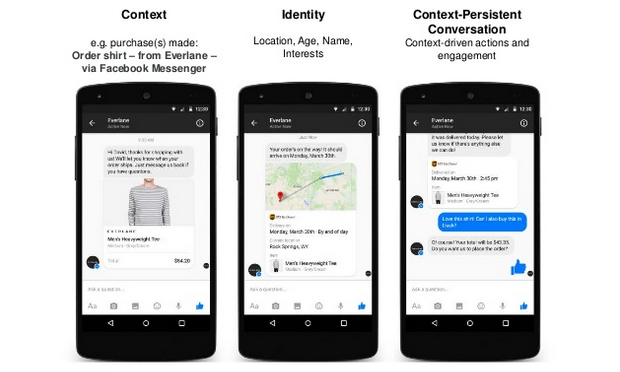
post
September 16, 2015
Are Mobile Messaging Apps Overtaking Text Messaging? Not Exactly
Back in May, venture capitalist and former Wall Street analyst Mary Meeker released her annual Internet trends report, highlighting social media, mobile and the Internet itself. One of her biggest findings, however, was the rapid growth of mobile messaging applications, which currently occupy six of the top ten slots for the most-used apps.

WhatsApp, the most popular messaging app on the market, saw its user base grow to 800 million over the past year. Snapchat, the blink-and-you’ll-miss-it photo messaging app, has a respectable user base as well, with over 100 million viewing two billion stories a day (20 views per person).
With mobile messaging apps showing such strong numbers, businesses feel encouraged to tap into the existing mobile audience. The most notable examples of a business messaging app is Facebook’s Businesses on Messenger and LinkedIn’s revamped messaging app. (For reference, the original Facebook Messenger boasts a strong user base of 600 million, up 20% from last year).

In the coming years, Meeker predicts that mobile messaging leaders will distinguish themselves based on context and identity (see above). In other words, Meeker is predicting that messaging apps will have the same back-end power that any software today does, thanks to integration with CRM software and other data sources.
Oddly enough, there’s a mobile messaging app that’s already does this. And it’s the one you’re most likely to overlook.
Texting Sends a Message
According to recent findings from Pew Research, the most-used app on a smartphone isn’t technically an app at all—it’s text messaging. And Pew found that not only do 97% of smartphone owners use texting—it’s also the “app” they use most frequently.
So if texting is the most-used app on a phone, why are businesses and consumers enamored with mobile messaging apps? Especially if all the reasons that Meeker listed below are equally applicable to text?

First, there’s the obvious answer that mobile apps are new and exciting, with their slick user interfaces and unique features (of course I want to send a message that lasts five seconds!) Secondly, mobile messaging apps are taking a slight lead over text messaging.
Mobile messaging apps, also known as over-the-top messaging apps (OTT), see users send over 1200 messages a month, compared to 113 for text messaging. However, as mobile analyst Karl Whitfield points out, that usage isn’t exactly what it seems:
Consumers tend to use OTT social chat apps differently to SMS. Knowing that there is no limit on the number of messages they can send, they write many more short messages (like with traditional desktop IM) rather than trying to maximise the 160 characters available in SMS.
In addition, Whitfield explains that mobile app users are primarily young people, while texting users are of all ages. And while WhatsApp may have 800 million frequent users, SMS has over 6 billion.
Should my company use mobile messaging apps or texting?
Now, mobile messaging apps are powerful, but they’re not strictly necessary. Because while 29% of smartphone users use messaging apps, 97% use text messaging. Texting is fast, it can be professional but personal, it’s easy to use, it’s in real-time, it picks up where you left off, it connects to the Internet, etc.
However, there are several features that mobile messaging apps pride themselves on, mainly:
- Free messaging internationally
- Group chats
- Multimedia content
- Location sharing
- Video calls and messages (FB Messenger)
But let’s break this down a bit. First, mobile messaging apps aren’t truly “free.” Unless you’re always at a Starbucks using their wifi, you’re going to be paying for the data or internet connection you use each month, just like you pay for your phone bill.
Secondly, group chats and multimedia content are available via SMS, and video calls are usually available via a native app on your phone. As industry analyst Benedict Evans points out, “your smartphone comes with three social networks out of the box, voice, SMS and email, and you use them all. Are you really going to add only one more?”
Finally, your friends or family must have a messaging app installed in order for you both to communicate. Mobile messaging apps may be popular, but if you and your friends aren’t using the same ones, it kind of defeats the purpose of using them in the first place.
But let’s break this last point down even further. Mobile messaging apps have a massive user base, but the use is largely youth-oriented. According to Pew Research, 90% of 18-29 year olds use messaging or auto-delete apps, like Snapchat, while less than half of 30-49 year olds do the same. Unless you’re marketing to Millennials, it’s going to be pretty hard to engage with potential customers over OTT apps.
Texting’s market penetration also massively outpaces that of mobile messaging apps. Over 80% of Americans text, but only 35% use WhatsApp and only 46% use Facebook Messenger. And if that’s not enough, 72% of business professionals prefer texting to messaging apps.
Below is a table breaking down the benefits of texting, WhatsApp and Facebook Messenger.
| Texting | FB Messenger | ||
| Market penetration (U.S.) | 81% | 35% | 46% |
| Voice | Yes | Yes | Yes |
| Geographic targeting | Yes | Yes | Yes |
| Login required | No | Yes | Yes |
| Needs Internet connection | No | Yes | Yes |
| Frequency used | >once a day | >once a day | >once a day |
| Connection to contacts | Yes | Yes | Yes |
| Mobile payments | Yes | Yes | Yes |
| Contact centers offering channel (%) | 37.6% | 25.9% | 25.9% |
| Customer preference (ranked 1 to 5, 1 being most preferred?) | 2.5/5 | 4.5/5 | 4.5/5 |
Conclusion
Before you dive into the world of mobile messaging apps, ask yourself one question:
Could I use text for that?
To learn more about adding text messaging to your business, download our whitepaper here.
Photo from Staffing in Stilettos.
Stay up to date
Latest Articles




